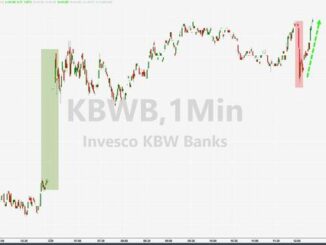
In 2024, some banks will fail. In 2023, five banks failed. In 1989, over 500 banks failed. Since 1936, there were only 5 years without bank failures.
By Wolf Richter for WOLF STREET.
The rate-cut-mania-inspired plunge in longer-term yields at the end of Q4, now partially reverse, had a salubrious effect on the balance sheets of commercial banks, according to the FDIC’s quarterly bank data released on Thursday.
In Q4 2023, “unrealized losses” on securities fell by $206 billion (or by 30%) from the prior quarter, to a cumulative loss of $478 billion, or 8.8% of the $5.43 trillion in securities held by those banks. The securities are mostly Treasury securities and government-guaranteed MBS.
These unrealized losses were spread over the two accounting methods:
HTM: Unrealized losses on the $2.50 trillion in held-to-maturity (HTM) securities fell by $116 billion from the prior quarter, to a cumulative loss of $274 billion (red in the chart below in total).
AFS: Unrealized losses on the $2.93 trillion in available-for-sale (AFS) securities fell by $90 billion from the prior quarter to $204 billion (blue).
These paper losses started piling up in 2022 when the Fed began tightening its monetary policy, which pushed up bond yields. Long-term securities are particularly impacted by rising yields. Rising yields means prices fall.
So as yields rose in 2022, the market prices of those securities fell, and record-breaking unrealized losses piled up, given the massive amounts of longer-term securities that banks had put on their balance sheet during the near-0% pandemic era.
At that time, the Fed printed trillions of dollars, part of which ended up as deposits in the banking system, and the banks, unhappy with T-bill yields of near 0%, plowed this cash into longer-term securities to get a yield that was more than 0%.
Total securities on bank balance sheets.
During the pandemic money-printing era, total securities held by banks soared by $2.5 trillion, or by 57%, to $6.2 trillion at the peak in Q1 2022.
By the end of 2023, the amount had dropped to $5.43 trillion, including the uptick in Q4. And the longer-term securities in this pile have lost a lot of market value. Several factors make up the decline, including:
The portion of securities of the collapsed banks that the FDIC sold to non-banks are no longer part of it.
Banks have written down AFS securities to market value.
Some securities matured
Banks may have sold some securities.
The $5.43 trillion in securities includes securities valued at market price and securities valued at purchase price.
Banks don’t have to mark these securities to market value, but can carry them at purchase price. The difference between market value and purchase price is the “unrealized gain or loss” that the bank must disclose in its quarterly financial filings.
In theory, “unrealized losses” on securities held by banks don’t matter because at maturity, whenever that may be, banks will be paid face value, and the unrealized loss diminishes as the security nears its maturity date, and goes to zero on the maturity date.
But these disclosures of unrealized losses made uninsured depositors aware of what is going on, and they started yanking their money out of Silicon Valley Bank, Signature Bank, and First Republic – on the two fundamental principles of investing:
He who panics first, panics best.
After me the deluge.
But the banks couldn’t raise the cash needed to fund this outflow by selling those securities because their unrealized losses would have become realized losses, and the banks couldn’t get enough cash for them, and were insolvent.
Loans and securities with a remaining maturity of:
15+ years: 14.5% of total assets, roughly stable in 2023.
5-15 years: 14.2% of total assets, lowest since Q3 2020.
3-5 years: 8.4% of total assets, lowest since Q3 2022.
Bank failures.
In the FDIC’s data going back to 1936, there were only five years without failures of FDIC-insured banks. During the two free-money years of the pandemic – 2021 and 2022 – no bank failed. In 2018, no bank failed. In 2006 and 2005, no bank failed. And that was it.
In each of the remaining 88 years, some banks failed. In 1989, at the peak of the S&L Crisis and following the oil bust, 531 banks failed – and people actually went to jail over it. In 2010, during the Financial Crisis, 155 banks failed. But by then, the banks were far larger than in 1989. And in an insidious turn of events, no one went to jail; instead, bankers at the banks that got bailed out made record bonuses.
In 2023, six banks collapsed: Silicon Valley Bank, Signature Bank, First Republic, plus two very small banks in Iowa and in Kansas were taken over by the FDIC. And Silvergate Bank, with regulators breathing down its neck, agreed to self-liquidate, but since it had enough assets to cover its deposits without FDIC involvement, the FDIC doesn’t count it as a “failed bank.” So officially, there were five “failed banks” and one self-liquidation.
In 2024, some banks will fail. We pretty much know that; we just don’t know how many. If eight banks fail, that would be on par with 2015 and 2017.
Commercial banks continue to vanish. In 2023, mergers took out 100 banks; bank failures and a self-liquidation took out 6 banks; but 6 new banks were started. At the end of 2023, the bank count was down to 4,026 commercial banks, from over 14,000 in the 1980s.
ENB Recommends the Wolf Street: Would you like to be notified via email when WOLF STREET publishes a new article? Sign up here.



